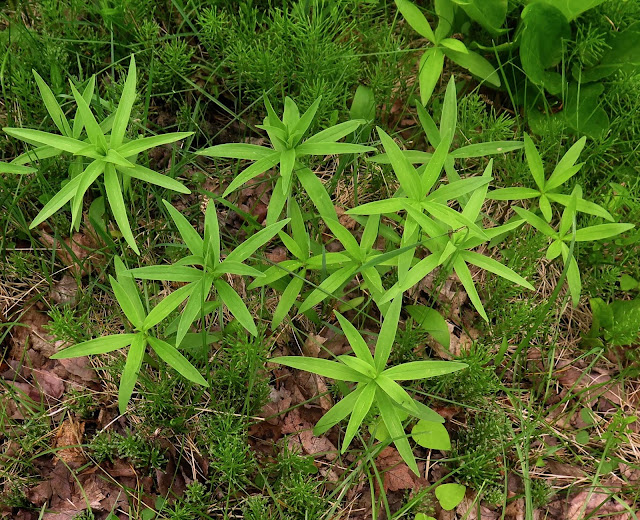I was so afraid my slow-to-heal knee would keep me off Bog Meadow Brook Nature Trail this spring. Ever since finding the beautiful Nodding Trilliums (Trillium cernuum) along this trail at least 16 years ago, I've returned each year in time to admire them anew. Happy for me, my knee pain from recent surgery has subsided sufficiently that I could walk at least part of this delightful and level trail quite easily, while these lovely flowers were still in bloom. And to add to my great pleasure, our dear friend Ruth Brooks had returned north from her winter Florida home, just in time to join me and our mutual friend Sue Pierce on our trillium hunt.
Of course, this trail offered many delights other than Nodding Trilliums. One of the first to halt our footsteps was this Painted Turtle right alongside the trail. We helped it cross the trail in the same direction it appeared to be heading. With wetlands on either side, it could have been either coming or going, and we wanted it to get where it wanted to go before some other trail-walker might think it would make a nice pet.
I was delighted to find many dozens of new shoots of Canada Lily (Lilium canadense) coming up, and only one single Scarlet Lily Beetle among the entire widely separated bunches. Not the dozens of ravaging beetles I once found each visit in recent years. A few years ago, hordes of this invasive beetle's larvae devoured nearly every single one of these lilies that once abundantly thrived at this location. Perhaps the larvae-devouring wasp introduced to our region few years ago has discovered this site at last!
Before we reached the section of trail where we expected we'd find Nodding Trilliums, we did enjoy several other native wildflowers that also grow here;
Grove Sandwort's tiny flowers (Moehringia lateriflora) spangled the trailside grasses like stars in the sky.
We were surprised to find a single plant of Golden Ragwort (Packera aurea) blazing its bright-yellow blooms along this open and relatively dry part of the trail. Further along, thousands would be thriving in a wooded swampy area we would not get to today.
Along the half-mile of the trail we walked today, only a single plant of Red Baneberry (Actaea rubra) did we see, distinguished from its White Baneberry relative by its spherical (rather than oblong) flower cluster and the slender pedicels of each floret. This baneberry also blooms a bit earlier than the white-berried one.
Starting about 20 miles north of Saratoga, populations of Rose Twisted Stalk (Streptopus lanceolatus) grow much more abundantly, but the two widely separated plants of it I find along Bog Meadow trail are the only ones I have found in Saratoga Counnty, at least, so far. What a treat to see it, with its tiny pink bells dangling down! Of course, you have to stoop low to see those charming little blooms, hiding beneath its leaves.
Ah, but we also had to stoop low to see the charming white blooms of Nodding Trillium dangling beneath its leaves. There seemed to be fewer of these native wildflowers this year, but perhaps they were simply better hidden this year by the huge leaves of Skunk Cabbage that also shares its habitat beneath trailside shrubs. Those Skunk Cabbage leaves were much more advanced on this year's date than in former years.
In previous years, I have found varying numbers of anomalous Nodding Trilliums, which appeared to be possible hybrids of the species T. cernuum with the related Red Trillium species (T. erectum), which also grows close by along this trail. The bloom time of the two species also overlaps slightly, so cross-pollination is a definite possiblility. I wondered if I would find any of these possible hybrids today. And well, I think I did! Just one, but its flower's tell-tale dark-rose color could be detected, even when half-hidden beneath its leaves:
Here's a better look at this rose-colored trillium bloom:
The petals of this anomalous trillium are closer in color to the scarlet of the petals of T. erectum. But the white ovary would signal that this was T. cernuum, since T. erectum has a red ovary. Also, the dark anthers are held erect on slender filaments from the ovary's base. The lighter anthers of T. erectum are virtually sessile to its ovary's base. Except for the color, then, this flower seems close to the straight species of T. cernuum. Would color be enough to think it might be a hybrid? I am curious what expert botanists might think. Whatever it is, it is certainly a beautiful anomaly!












2 comments:
Beautiful. So happy to hear that you are out and about again.
Love those nodding trilliums, which I've never seen. The Rose Twisted Stalk is one of my favourites.
Thanks, Rosalea! I, too, am delighted to be out and about again, finding so many beautiful wildflowers before they disappear for the year. I was so afraid I would miss them all. I'm glad these waited for my return to their habitat.
Post a Comment